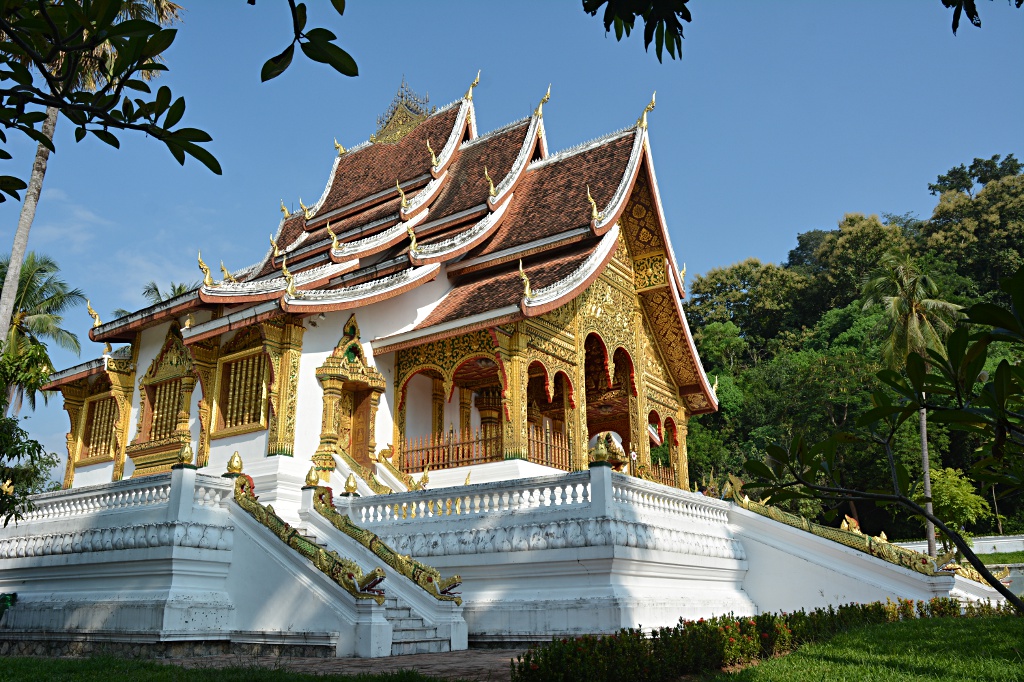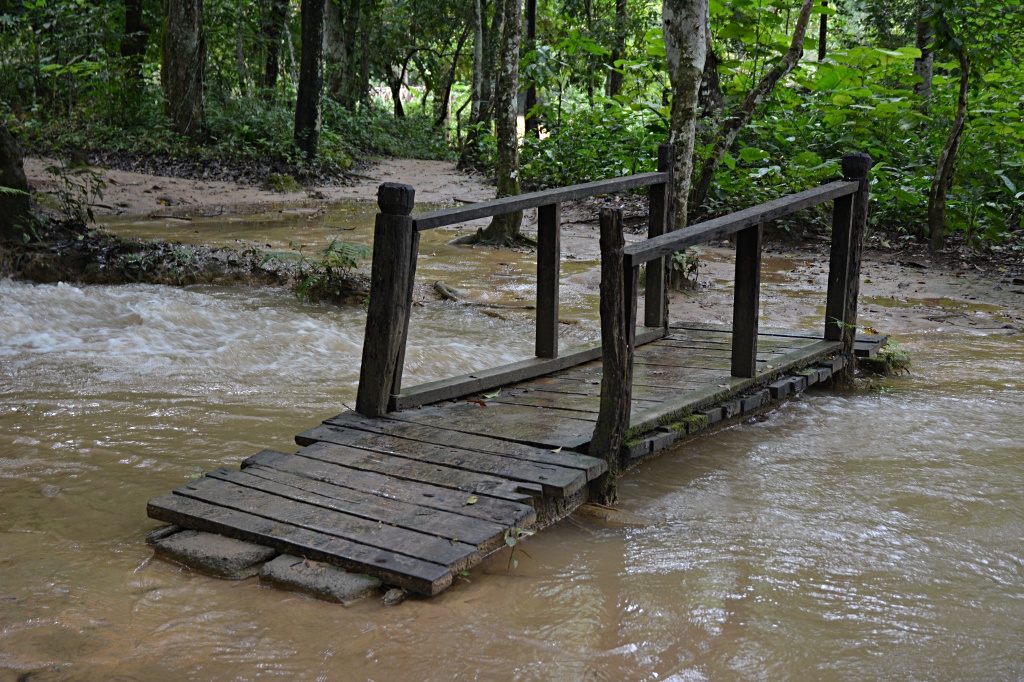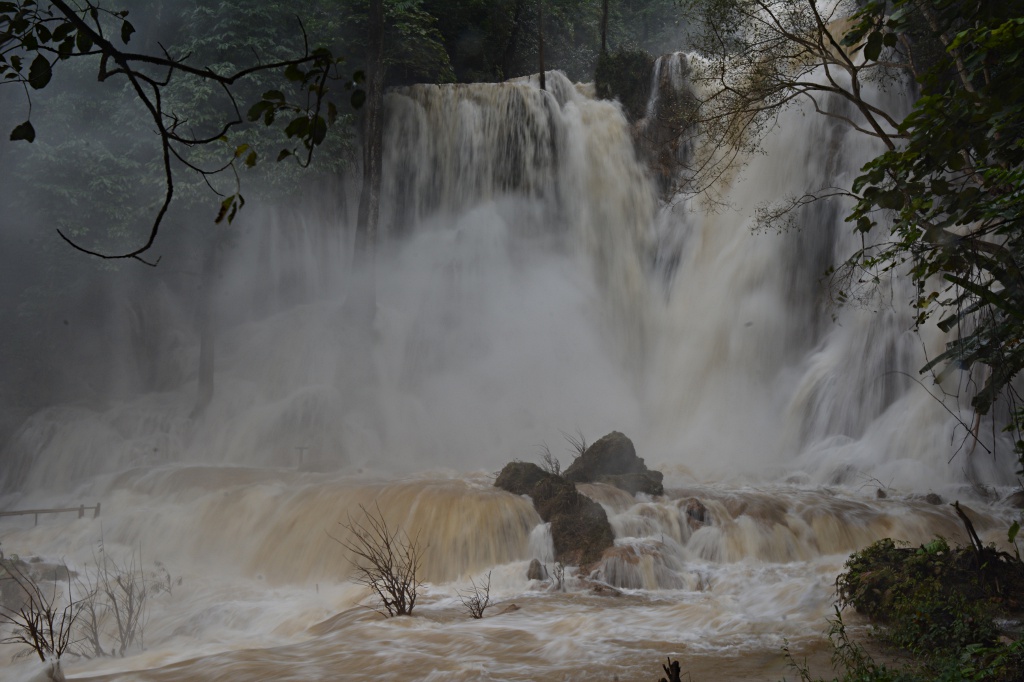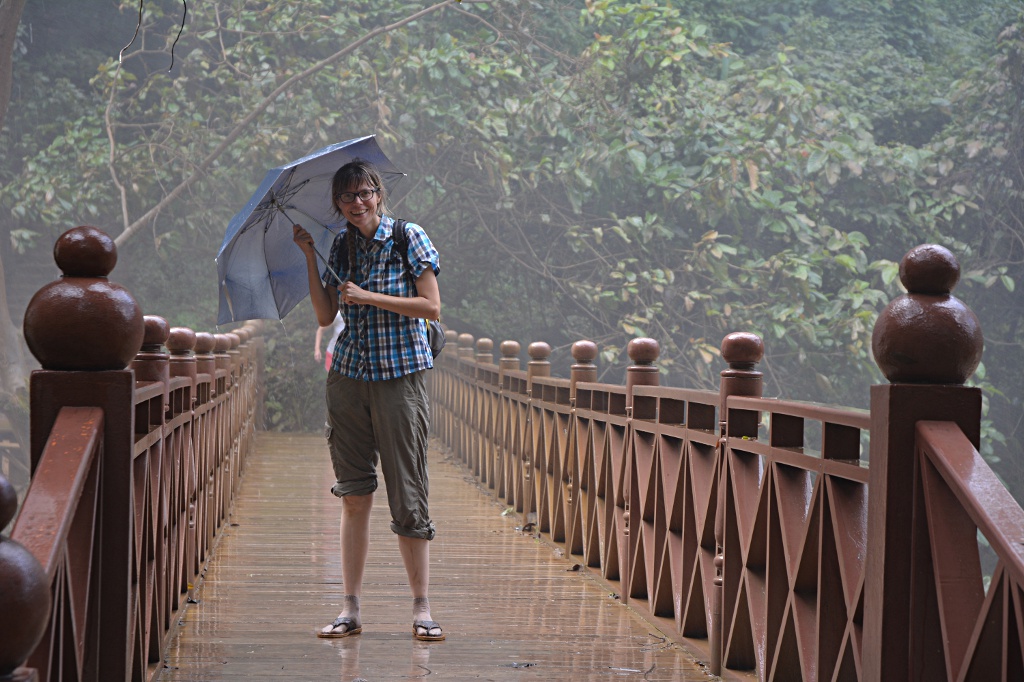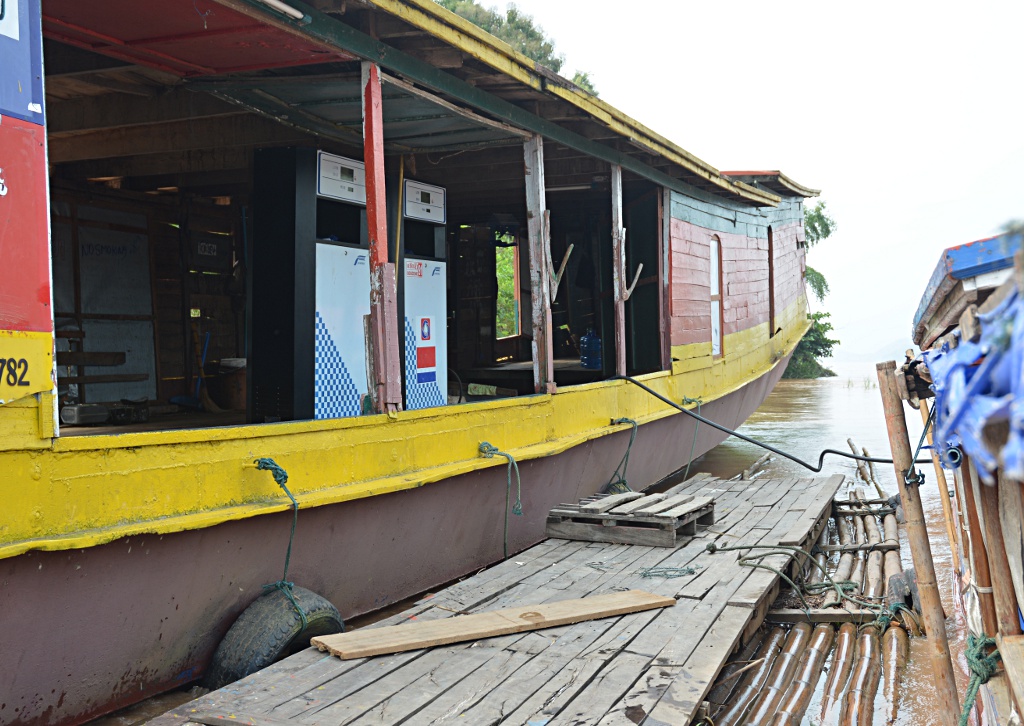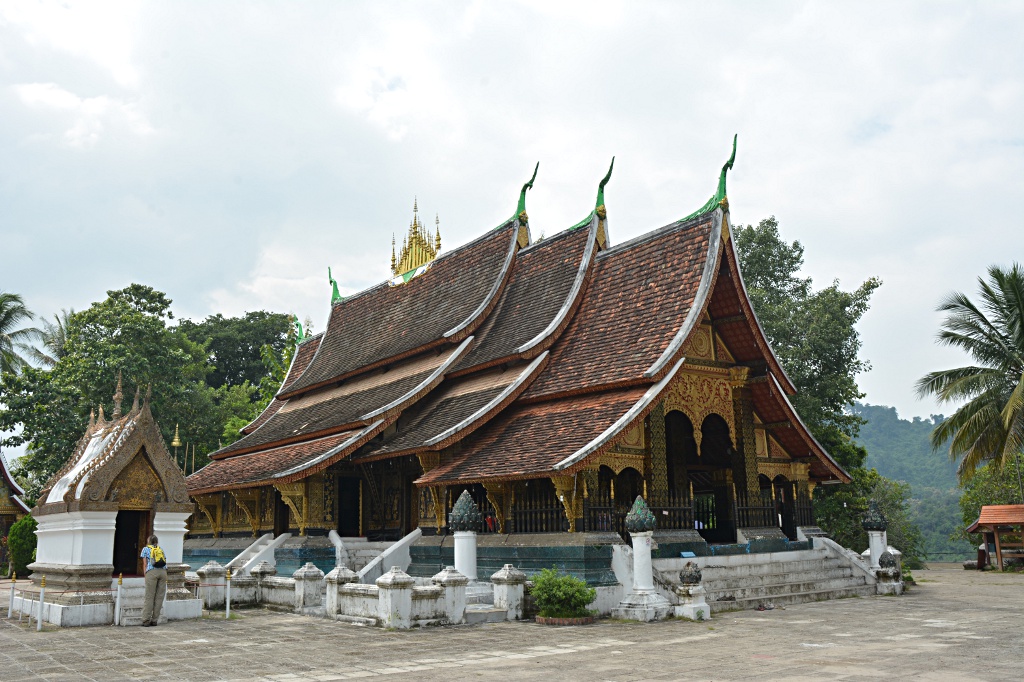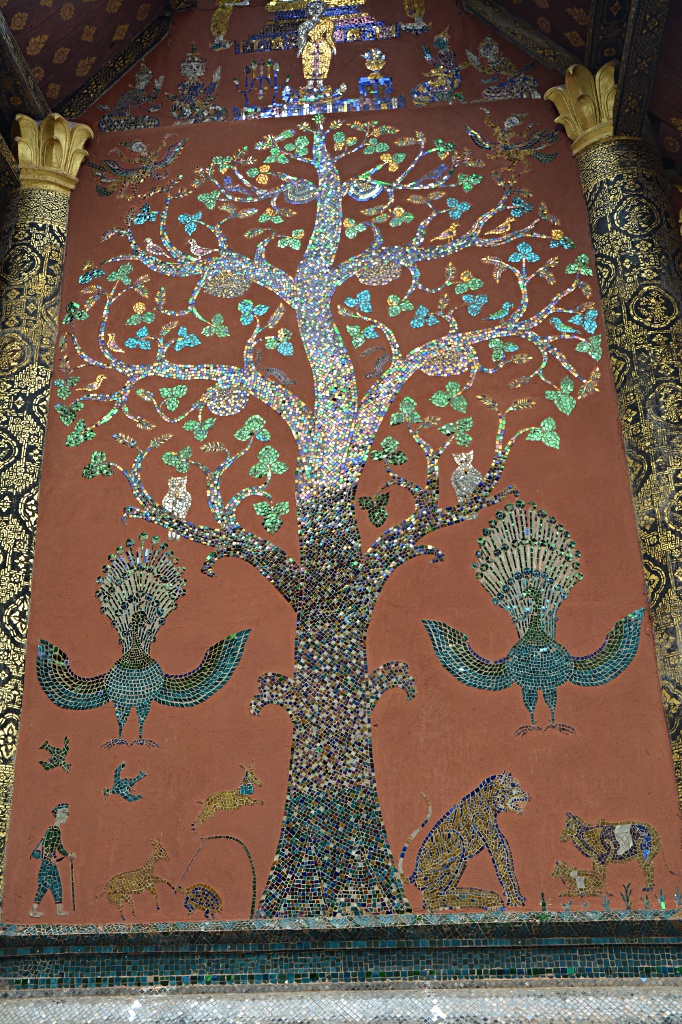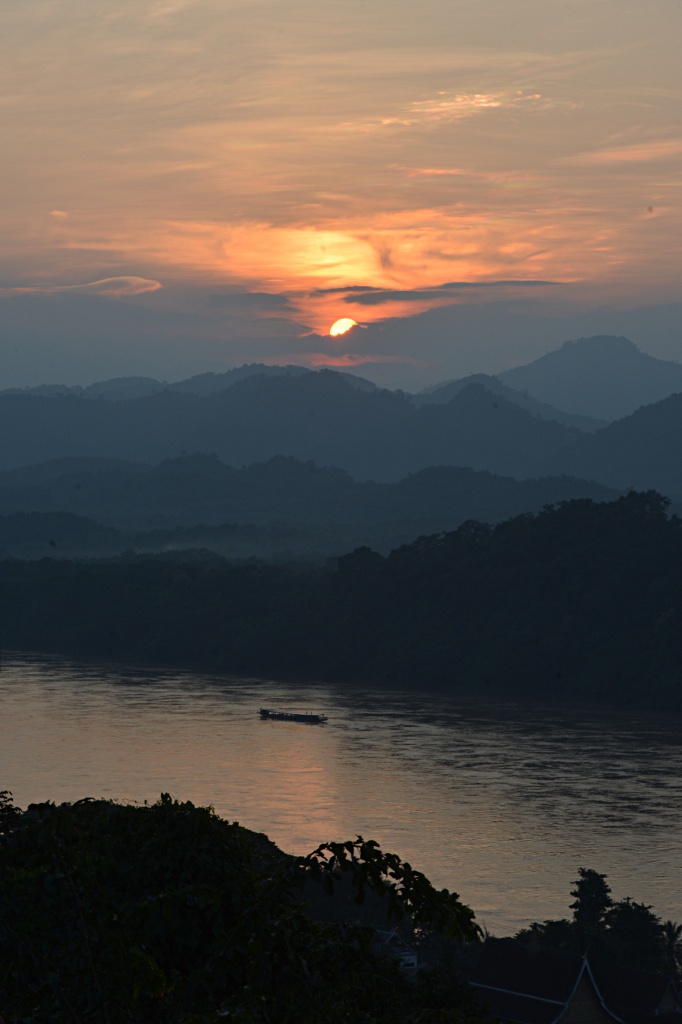After our visit to the far north of Laos we targeted another highlight of our trip: the UNESCO heritage city of Luang Prabang, the second largest city of the country. Sporting an international airport, a shore of the mighty Mekong river and being branded by the UNESCO made it no surprise that we were not the only tourists in town. Unfortunately it also shows with the local people dealing with tourists that they have learned a lot, particularly how to make money from the tourists.
The minibus brought us in record time from Nong Khiaw to Luang Prabang, fortunately all in one piece. It seems like the driver had to make a lunch meeting, only this could explain why he was literally flying along the bumpy road. This was most unfortunate for the one passenger who typically gets car-sick very easily. Lucky for her though her medicine worked wonders and she completed the journey at neck breaking speed without any incident. At 11:30 am we pulled up to the North Bus Station in Luang Prabang where we had the first encounter with the apparently spoilt tuk-tuk drivers. We politely declined their outrageous offer to bring us to the city center for an inflated price and opted for one of the guys just outside the bus station to bring us near the night market for a reasonable price. Since the drop-off location was very convenient for all passengers even we didn’t have to walk too far to find a place to sleep the following three nights. It seemed that all the guesthouses had agreed on a common price in the one road where we were looking…
Having dropped off our backpacks we immediately went on to explore the city a little bit. We first took a look at the historic city center, which is the main tourist draw. We were quite surprised by the standard of the restaurants and cafés along the main road. Sporting white table cloths the standard of these places was far superior of what we had seen so far in Laos.
While the old town of Luang Prabang is lovely, we are always also interested in the life outside of the touristy world. The urge to see more was an excellent combination with the need to get Lenka’s trekking shoe repaired. Through a pointer received in Nong Khiaw we soon found a shoe repair shop consisting of a small table, an even smaller chair and a handful of tools and threads. He immediately proposed a solution to the sole which was falling off the shoe which he realized using glue and a solid thread. His work made us optimistic that the shoe would make it to the end of this trip.
On one of our city maps for Luang Prabang we saw that the was a Vietnamese consulate not far from the city center and particulary the place where we were at the time. We decided to drop by to learn more about application process, pricing and timing. Unfortunately we brought neither enough cash nor our passports such that we couldn’t apply right away. So we just picked up the application form and decided to return the next morning bringing the completed form, the picture, the passport and the money in US dollars. We opted to use their next day service, the quickest they had to offer, to get the visa.
On the way to dinner and our guesthouse, we came across the Dara Market, where I finally found a pair of flip-flops for my, by Asian standard, huge feet.
The next morning we had planned a trip to the nearby Kuangxi waterfall, but had to postpone it for a bit due to some sudden and fortunately short stomach issues Lenka was encountering. It just lasted long enough to take care of Lenka and let her rest for a bit while I got a hair-cut. Lenka was quickly back on her feet such that we could start looking for people joining us just after lunch. Soon we came across a pair of Dutch and an English fellow who had already negotiated a good price with one of the tuk-tuk drivers. So we finally divided the cost of the trip among three parties. Once we reached the waterfalls our driver asked to collect the money for the entrance tickets claiming that we would get a small commission. However he never bought any tickets and was joking with the ticket check person while we passed the entrance gate. There seemed to be a fishy deal going on between the two. Fortunately the deal didn’t have any consequences for us.
On the way to the cascades we soon realized that it had been a good idea to bring our flip-flops. Due to the high water levels a large part of the tourist area was flooded and we had to wade through the water to make it up to the waterfalls. The amounts and power of the water were once again impressive. We were warned by a young German fellow, that we would get wet in case we wanted to cross the bridge in front of the waterfall. He had certainly gotten wet from head to toe.
The thundering waterfall sprayed out enough water to extinguish a forest fire. Fortunately we were prepared for any kind of weather from our earlier experience in Laos such that we reached into our day-pack to produce a couple of nice Chinese fold able umbrellas which would protect us from getting soaked. The view from the other side gave another good perspective on this huge waterfall.
Unfortunately we ran out of time to visit the ButterflyPark a few hundred meters from the waterfall. Tourists just returning from there were eagerly recommending place. Having seen quite a few amazing butterflies in Laos so far we can only imagine how many beatiful creatures could be seen there.
When we arrived back in Luang Prabang we got prove of how the local people have adjusted to the tourists with full wallets. Our tuk ruk driver had already collected the money from the two Dutch guys who had originally negotiated the fare. Therefore they immediately left once we arrived in the city. The driver immediately used the situation to demand double the price from us. While the English fellow didn’t hesitate to pay, we refused, causing a major discussion. Eventually with the help from the Dutch guys we confirmed what the correct price was, handed the screaming driver his money and left him standing there. Ultimately we were not surprised that he could drive what was probably the newest tuk-tuk in town.
On our second day in Lunag Prabang we started the day again with a search for mates for an excursion. This time we wanted to take a boat ride on the Mekong to reach the Pak Ou caves. The caves are famous for containing lots of Buddhas which once were used in temples and shrines, but just didn’t cut it anymore in terms of beauty. At the same place where we had found the Dutch guys the day before I ran into Ricky from Denmark who told me that she and her 4 travelmates had the same plan. Once everyone was assembled we headed off towards the pier to find a boat which would bring us to the caves. The divergence of price asked by the boatmen and what we thought was reasonable made us uncertain whether a boat would be the right means of transport. Since some of the people only would join in, if we took the boat, so we adjusted our expectations and with a little bit of negotation we ultimately rented a beautful boat with nice wooden window frames and cute little curtains.
We enjoyed the 2-hour-trip upstream on the Mekong river and on the way learned that gas stations on the river work pretty much the same way as on roads. We came across a large barge on the river bank which had two gas pumps installed. Using the long hose and nozzle our boat was quickly refilled and we continued our way upstream in almost no time. The Pak Ou caves turned out to be rather underwhelming, while still having a special atmosphere. On the way back we quickly dropped by a small village known as the Wiskey village due to the presence of a few home-sized distilleries. The village ended up looking more like a shopping street for the local rice whiskey (Lao Lao) and weaved textiles produced there.
Back in Luang Prabang we were let go right in front of the famous Wat Xieng Toung. This fit our plan perfectly as we intended to visit that temple next. One of the striking features of the temple where its images on the outside. These were done through colored mirrors which made the pictures appear differently as one moved in different places in front of it. Our following visit to the National Museum was cut short, since the gallery was already closed. We still could explore the beautiful gardens in front though.
It was almost time for us to pick up our passports from the Vietnamese consulte, so we decided to head that way. The visas were already ready such that we could move on to the Phousi Stupa on top of the hill by the same name. Heading up the backside led us to a huge hole in a rock which is believed to be a foot imprint of Buddha himself. Nearby a young monk was eager to chat such that we could learn a few things from him. We never expected to be the only ones to observe the sunset from the top of the hill on this almost perfect day, but it was still surprising to see especially so many Asian tourists. It was the first time, besides tourist attractions in China, that we saw more Asian tourists than people from Western countries.
Once the sun had set we started our nightly hunt for good food on the night market. Since we were still quite full from the late lunch, we were only looking for a small snack which we eventually found in the small snack street leading off the night market. Once again we tasted a fruit shake which immediately made into our top three, now consisting of Mango, Lemon/Mint and Passion fruit.
Despite having been woken up by a group of young, drunk British in the middle of the night, we managed to get up at 6 am in the morning to head out to the bus station. We had decided to avoid spending just as much money on the travel agents than on the tickets and buy the tickets directly from the bus station. Avoiding this extra means an extra night in a nice guesthouse for each transport ticket. At 8:30 am finally a long and gruesome journey by local bus started for our next destination.

